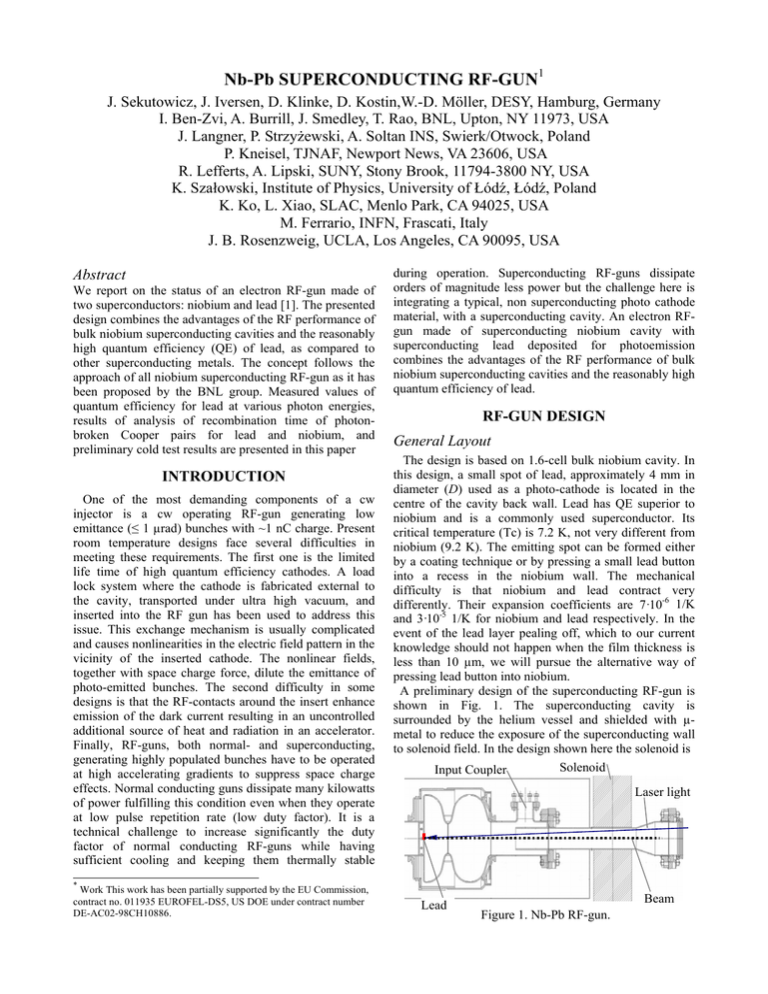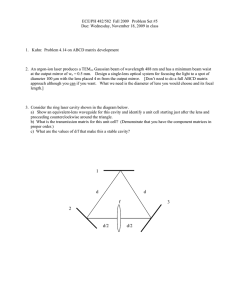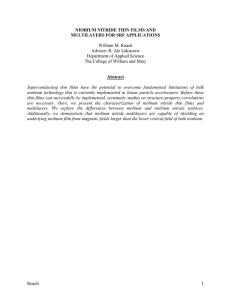Nb-Pb SUPERCONDUCTING RF-GUN
advertisement

Nb-Pb SUPERCONDUCTING RF-GUN1 J. Sekutowicz, J. Iversen, D. Klinke, D. Kostin,W.-D. Möller, DESY, Hamburg, Germany I. Ben-Zvi, A. Burrill, J. Smedley, T. Rao, BNL, Upton, NY 11973, USA J. Langner, P. Strzyżewski, A. Soltan INS, Swierk/Otwock, Poland P. Kneisel, TJNAF, Newport News, VA 23606, USA R. Lefferts, A. Lipski, SUNY, Stony Brook, 11794-3800 NY, USA K. Szałowski, Institute of Physics, University of Łódź, Łódź, Poland K. Ko, L. Xiao, SLAC, Menlo Park, CA 94025, USA M. Ferrario, INFN, Frascati, Italy J. B. Rosenzweig, UCLA, Los Angeles, CA 90095, USA Abstract We * report on the status of an electron RF-gun made of two superconductors: niobium and lead [1]. The presented design combines the advantages of the RF performance of bulk niobium superconducting cavities and the reasonably high quantum efficiency (QE) of lead, as compared to other superconducting metals. The concept follows the approach of all niobium superconducting RF-gun as it has been proposed by the BNL group. Measured values of quantum efficiency for lead at various photon energies, results of analysis of recombination time of photonbroken Cooper pairs for lead and niobium, and preliminary cold test results are presented in this paper INTRODUCTION One of the most demanding components of a cw injector is a cw operating RF-gun generating low emittance (≤ 1 µrad) bunches with ~1 nC charge. Present room temperature designs face several difficulties in meeting these requirements. The first one is the limited life time of high quantum efficiency cathodes. A load lock system where the cathode is fabricated external to the cavity, transported under ultra high vacuum, and inserted into the RF gun has been used to address this issue. This exchange mechanism is usually complicated and causes nonlinearities in the electric field pattern in the vicinity of the inserted cathode. The nonlinear fields, together with space charge force, dilute the emittance of photo-emitted bunches. The second difficulty in some designs is that the RF-contacts around the insert enhance emission of the dark current resulting in an uncontrolled additional source of heat and radiation in an accelerator. Finally, RF-guns, both normal- and superconducting, generating highly populated bunches have to be operated at high accelerating gradients to suppress space charge effects. Normal conducting guns dissipate many kilowatts of power fulfilling this condition even when they operate at low pulse repetition rate (low duty factor). It is a technical challenge to increase significantly the duty factor of normal conducting RF-guns while having sufficient cooling and keeping them thermally stable during operation. Superconducting RF-guns dissipate orders of magnitude less power but the challenge here is integrating a typical, non superconducting photo cathode material, with a superconducting cavity. An electron RFgun made of superconducting niobium cavity with superconducting lead deposited for photoemission combines the advantages of the RF performance of bulk niobium superconducting cavities and the reasonably high quantum efficiency of lead. RF-GUN DESIGN General Layout The design is based on 1.6-cell bulk niobium cavity. In this design, a small spot of lead, approximately 4 mm in diameter (D) used as a photo-cathode is located in the centre of the cavity back wall. Lead has QE superior to niobium and is a commonly used superconductor. Its critical temperature (Tc) is 7.2 K, not very different from niobium (9.2 K). The emitting spot can be formed either by a coating technique or by pressing a small lead button into a recess in the niobium wall. The mechanical difficulty is that niobium and lead contract very differently. Their expansion coefficients are 7·10-6 1/K and 3·10-5 1/K for niobium and lead respectively. In the event of the lead layer pealing off, which to our current knowledge should not happen when the film thickness is less than 10 µm, we will pursue the alternative way of pressing lead button into niobium. A preliminary design of the superconducting RF-gun is shown in Fig. 1. The superconducting cavity is surrounded by the helium vessel and shielded with µmetal to reduce the exposure of the superconducting wall to solenoid field. In the design shown here the solenoid is Solenoid Input Coupler Laser light * Work This work has been partially supported by the EU Commission, contract no. 011935 EUROFEL-DS5, US DOE under contract number DE-AC02-98CH10886. Lead Beam Figure 1. Nb-Pb RF-gun. normal conducting but the alternate option of a superconducting solenoid placed in the cryostat is technically possible. Modelling of the solenoid showed a small residual field of 1 Gauss at the beam tube iris when only one µ-metal layer is applied for the shielding. In practice, the solenoid will be switched on after the cavity reaches its superconducting state, thus no intrinsic Qo degradation is expected due to the Meissner effect. The input coupler is placed in isolation in vacuum (not in helium bath). For the final beam energy of ~6 MeV and the nominal current of 1 mA (1nC/bunch, 1 MHz repetition frequency) the input coupler will transfer about 6 kW of RF power to the generated beam. This is within the TTF type III coaxial coupler capability with marginally improved cooling. Cavity Design Mode Table 2. Parameters of parasitic modes f [MHz] (R/Q) Monopole: Beam Tube 793.9 57.9 [Ω] Dipole: TE111-1H 1641.8 1.85 [Ω/cm2] Dipole: TE111-1V 1644.9 1.30 [Ω/cm2] Dipole: Beam Tube-H 1686.3 3.33 [Ω/cm2] Dipole: Beam Tube-V 1754.7 5.13 [Ω/cm2] Dipole: TM110-1H 1883.5 10.1 [Ω/cm2] Dipole: TM110-1V 1884.0 9.99 [Ω/cm2] Dipole: TM110-2H 1957.0 3.90 [Ω/cm2] Dipole: TM110-2V 1957.1 3.85 [Ω/cm2] Monopole: TM011 2176.5 43.2 [Ω] The geometry of the RF-gun cavity is based on the Low Loss shape (LL). The cavity, as shown in Fig. 2, was modelled, first in 2D for the cell shape optimization, and then in 3D [2] with the coaxial input coupler and two HOM couplers attached. The result of 3D modelling of Input Coupler HOM Coupler HOM Coupler Figure 2. 1.6-cell Nb-Pb RF-gun Figure 3. HOMs damping (Qext). Pb QUANTUM EFFICIENCY π-mode frequency [MHz] 1300 0-mode frequency [MHz] 1286.5 Cell-to-cell coupling - 0.015 Nominal Ecath at cathode [MV/m] 60 Energy stored at nominal Ecath [J] 20 Nominal beam energy [MeV] 6 248 nm QE Table 1. Parameters of RF-gun cavity Parameter Unit 230 nm 190 nm 200 nm Pb: vacuum-deposited Pb: bulk Pb: electro-plated Nb: bulk Pb: arc-deposited Pb: magnetron-deposited 220 nm 213 nm 210 nm 0.006 193 nm We used an existing room temperature setup at BNL for the QE measurements of various lead samples [3]. The samples were illuminated with KrF Excimer, ArF Excimer, Nd:YAG (4th harmonic) lasers and with a 240 nm the external coupling (Qext) for the fundamental mode as a function of the penetration depth of the input coupler inner conductor showed that nominal Qext=3.5·107 (for the 1 mA and 6 MeV beam) is obtained when the inner conductor marginally penetrates the beam tube. Data of the fundamental mode passband and the nominal operation data are listed in Table 1. The modelling also estimated the asymmetry in the accelerating field caused by the couplers to be of order 10-3. Finally, the frequencies, (R/Q)s and damping of the monopole and dipole passbands were also computed with the 3D code. The computed data of parasitic modes is shown in Table 2 and in Fig. 3. 0.000 4.0 4.5 5.0 5.5 Ep [eV] 6.0 6.5 7.0 Figure 4. Measured QE of lead deposited with various coating methods as function of photon energy. Bulk Pb and Nb data are displayed for comparison. deuterium light source fiber-coupled to a monochromator (output bandwidth 2 nm). The QE data for the lead samples is summarized in Fig. 4. The Pb surfaces were cleaned with pulsed laser beam of 248 nm wavelength and 10 ns duration time to improve the QE. A single pulse energy density of ~0.2 mJ/mm2 with a total of 104 pulses was found to provide the maximum QE with minimal change to the surface morphology. Arc-deposited lead demonstrated both the best QE and the best surface quality. 1.E+10 Qo 1.E+09 With lead No lead 1.E+08 COLD TESTS 0 Two half-cell cavities, 1.3 GHz at DESY and 1.42 GHz at JLab, have been built for QE measurements at 2 K and RF performance tests with lead spot located at centre of the endplate (Fig. 5). For the DESY cavity lead was arcdeposited. For the JLab cavity lead was electroplated on the Nb plug. The cavities have been tested preliminary for the RF performance. No QE test at 2K has been conducted up to now. Results of the RF tests, without and with lead, are shown in Fig. 6 and 7. In both cases performance is to be improved with a better cleaning before and after the deposition (DESY cavity) and a better plug cooling (JLab cavity). 5 10 15 20 25 30 Epeak [MV/m] Figure 7: 2K test: JLab half-cell with and without lead. pairs will be broken by the laser pulse. They will form an excess of quasi-particles as compared to their density due to the thermal equilibrium. Their recombination time, to form back the Cooper pairs, depends on temperature (see Fig. 8). By irradiation of the emitting spot with intense laser light when cavity has very high intrinsic quality factor we should be able to benchmark our theoretical estimation of τr. 10000 Nb 1000 Pb 100 10 τr [ns] 1 0.1 Figure 5: Test cavities; (left) DESY option with closed endplate, (right) JLab option with hole in the endplate and plug (marked in red). 0.01 2 4 6 T [ K] 8 10 Figure 8: Relaxation time in lead and niobium vs. T. 1.E+11 No Lead With Lead 1.E+10 Qo 1.E+09 1.E+08 0 25 50 Epeak [MV/m] 75 Figure 6: 2K test: DESY half-cell with and without lead. TWO QUESTIONS TO BE ANSWERED In near future, two questions we need to answer experimentally with a prototype of the SRF gun as it is shown in Fig. 1. At first, we have to verify the estimated relaxation time τr of quasi-particles generated during the irradiation process in the ~10 nm thin layer of the emitting spot. The layer absorbing almost whole photons energy will lose its superconducting state since all Cooper The second question is the thermal emittance. To keep the laser power as low as possible, one needs to irradiate the lead cathode with wavelength close to 200 nm. At this wavelength, assuming 4.25 eV work function of lead, 1mm radius of the spot and 60 MV/m electric field on the cathode, thermal emittance can be estimated to be 1.25 µrad. This value is above our spec and if confirmed experimentally will force us to operate the gun with lower charge (~0.4 nC) generated from the spot of smaller ~0.7mm radius. REFERENCES [1] J. Sekutowicz et al., “Nb-Pb superconducting RFgun”, TESLA-FEL Report 2005-09, DESY, Hamburg, December 2005. [2] Z. Li et al., “X-Band Linear Collider R&D in Accelerating Structures Through Advanced Computing”, EPAC04, Lucerne, Swiss, 2004. [3] J. Smedley et al., “Photoemission Properties of Lead”, EPAC04, Lucerne, Swiss, 2004.



